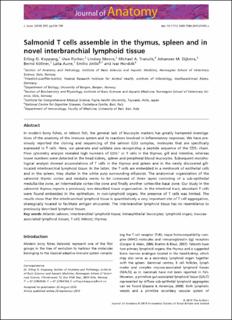| dc.contributor.author | Koppang, Erling Olaf | |
| dc.contributor.author | Fischer, Uwe | |
| dc.contributor.author | Moore, Lindsey | |
| dc.contributor.author | Tranulis, Michael Andreas | |
| dc.contributor.author | Dijkstra, Johannes Martinus | |
| dc.contributor.author | Köllner, Bernd | |
| dc.contributor.author | Aune, Laila | |
| dc.contributor.author | Jirillo, Emilio | |
| dc.contributor.author | Hordvik, Ivar | |
| dc.date.accessioned | 2021-10-18T09:15:31Z | |
| dc.date.available | 2021-10-18T09:15:31Z | |
| dc.date.created | 2011-01-17T12:56:28Z | |
| dc.date.issued | 2010 | |
| dc.identifier.citation | Journal of Anatomy. 2010, 217 (6), 728-739. | |
| dc.identifier.issn | 0021-8782 | |
| dc.identifier.uri | https://hdl.handle.net/11250/2823613 | |
| dc.description.abstract | In modern bony fishes, or teleost fish, the general lack of leucocyte markers has greatly hampered investigations of the anatomy of the immune system and its reactions involved in inflammatory responses. We have previously reported the cloning and sequencing of the salmon CD3 complex, molecules that are specifically expressed in T cells. Here, we generate and validate sera recognizing a peptide sequence of the CD3ε chain. Flow cytometry analysis revealed high numbers of CD3ε+ or T cells in the thymus, gill and intestine, whereas lower numbers were detected in the head kidney, spleen and peripheral blood leucocytes. Subsequent morphological analysis showed accumulations of T cells in the thymus and spleen and in the newly discovered gill-located interbranchial lymphoid tissue. In the latter, the T cells are embedded in a meshwork of epithelial cells and in the spleen, they cluster in the white pulp surrounding ellipsoids. The anatomical organization of the salmonid thymic cortex and medulla seems to be composed of three layers consisting of a sub-epithelial medulla-like zone, an intermediate cortex-like zone and finally another cortex-like basal zone. Our study in the salmonid thymus reports a previously non-described tissue organization. In the intestinal tract, abundant T cells were found embedded in the epithelium. In non-lymphoid organs, the presence of T cells was limited. The results show that the interbranchial lymphoid tissue is quantitatively a very important site of T cell aggregation, strategically located to facilitate antigen encounter. The interbranchial lymphoid tissue has no resemblance to previously described lymphoid tissues. | |
| dc.description.abstract | Salmonid T cells assemble in the thymus, spleen and in novel interbranchial lymphoid tissue | |
| dc.language.iso | eng | |
| dc.title | Salmonid T cells assemble in the thymus, spleen and in novel interbranchial lymphoid tissue | |
| dc.type | Peer reviewed | |
| dc.type | Journal article | |
| dc.description.version | publishedVersion | |
| dc.subject.nsi | VDP::Zoologiske og botaniske fag: 480 | |
| dc.subject.nsi | VDP::Zoology and botany: 480 | |
| dc.source.pagenumber | 728-739 | |
| dc.source.volume | 217 | |
| dc.source.journal | Journal of Anatomy | |
| dc.source.issue | 6 | |
| dc.identifier.doi | 10.1111/j.1469-7580.2010.01305.x | |
| dc.identifier.cristin | 525525 | |
| cristin.unitcode | 192,16,1,0 | |
| cristin.unitname | Institutt for basalfag og akvamedisin | |
| cristin.ispublished | true | |
| cristin.fulltext | original | |
| cristin.qualitycode | 1 | |
